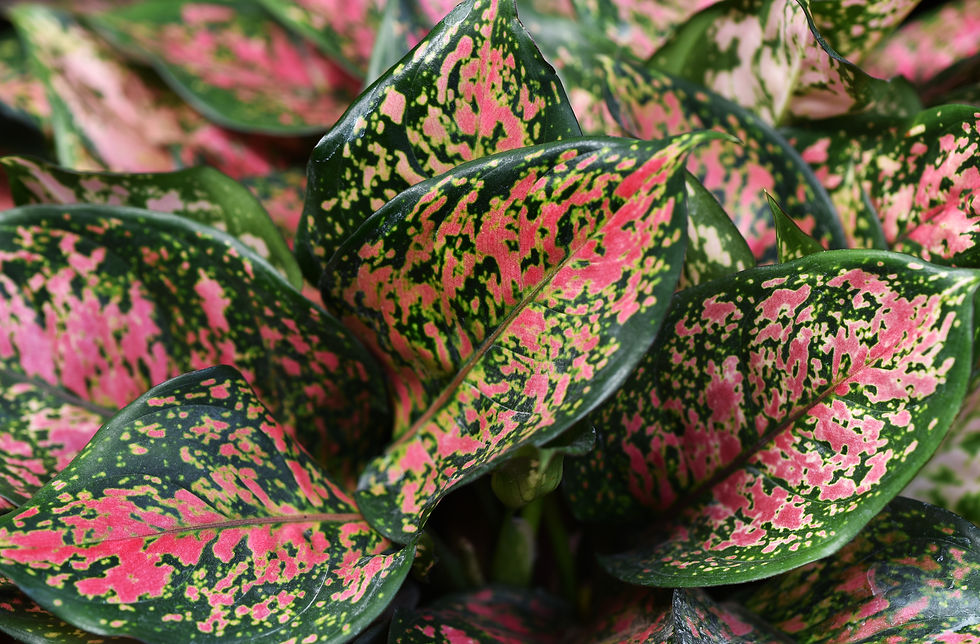The Allure of Aroids: A Pothead's Guide
- Mark C
- Feb 20
- 4 min read
As a fellow Pothead (by which I mean potted plant enthusiast, of course) I have always found myself captivated by the diverse and enchanting world of aroids. The Aroid family, scientifically known as Araceae (are-a-SEE-yay), consists of over 3,700 species, ranging from the well-known Philodendron to the exotic Alocasia and the striking Monstera. Aroids are not just plants; they are living art pieces that bring life and character into your home.
All about Aroids
The Araceae family is a fascinating group of flowering plants that are predominantly found in tropical and subtropical regions. Aroids can be recognized by their unique inflorescence, which typically consists of a spadix—a fleshy spike that is surrounded by a modified leaf known as a spathe. This intriguing structure is not only a hallmark of aroids but also plays a crucial role in their reproduction. The taxonomy of aroids is extensive, with several genera that are particularly popular among houseplant enthusiasts. Some of the most beloved are discussed below:

Philodendron is a diverse genus of plants known for their lush foliage and ability to thrive in a variety of indoor conditions. These tropical plants are not only popular for their aesthetic appeal, with heart-shaped leaves and vibrant green colors, but also for their air-purifying qualities, making them an excellent choice for enhancing indoor environments.
Scindapsus, often referred to as pothos or devil's ivy, is a popular houseplant known for its lush, heart-shaped leaves that can be variegated with shades of green, yellow, or white. This resilient plant thrives in a variety of indoor conditions, making it an ideal choice for both novice and experienced plant enthusiasts, as it can tolerate low light levels and infrequent watering.

Syngonium, commonly known as the arrowhead plant, is a popular choice among houseplant enthusiasts due to its attractive foliage and ease of care. This tropical vine thrives in a variety of light conditions and can adapt to different environments, making it an ideal indoor plant. With its arrowhead-shaped leaves that can vary in color from green to pink and redand tha often feature, Syngonium adds a touch of elegance to any space. Regular watering and occasional pruning can encourage lush growth, while its ability to climb or trail makes it versatile for various display options.
Monstera is a captivating tropical plant, renowned for its large, glossy leaves that feature unique splits and holes. This distinctive foliage not only adds aesthetic appeal but also thrives in various indoor environments. Native to Central America, Monstera prefers bright, indirect light and requires minimal maintenance, which contributes to its widespread popularity. Additionally, it can grow quite large, creating a dramatic focal point in any room. Its air-purifying qualities further enhance its desirability, making Monstera a perfect blend of beauty and functionality for modern living spaces.

Alocasia is known for their striking foliage and unique leaf shapes. These plants are native to various regions in Southeast Asia and are often cultivated for ornamental purposes due to their dramatic appearance. Alocasia species thrive in humid environments and require well-draining soil to flourish. Their large, arrow-shaped leaves can vary in color and texture. Alocasia plants can grow quite tall, adding an exotic touch to indoor and outdoor spaces. Proper care, including adequate light and moisture, is essential for maintaining their health and vibrancy.
Dieffenbachia, commonly known as dumb cane, is a popular houseplant renowned for its striking foliage and ease of care. This tropical plant features large, lush leaves that often display a beautiful variegation of green and cream or yellow, making it an attractive addition to indoor spaces. Dieffenbachia thrives in indirect sunlight and prefers a warm, humid environment, which mimics its native habitat in the tropical rainforests of Central and South America. However, it is important to handle this plant with care, as its sap can be toxic if ingested, leading to irritation and swelling of the mouth and throat. Proper watering and occasional fertilization can promote healthy growth, allowing this elegant plant to flourish and enhance the aesthetic of any room. With the right conditions, Dieffenbachia can grow quite tall, reaching several feet in height, and can become a stunning focal point in home decor.

Aglaonema, commonly known as Chinese evergreen, is a popular houseplant recognized for its striking foliage and resilience. With a variety of species and cultivars, Aglaonema showcases lush, green leaves often adorned with vibrant patterns of silver, red, or pink. This plant thrives in low to moderate light conditions, making it an ideal choice for indoor environments. Additionally, it requires minimal care, needing only occasional watering and well-draining soil.
The discovery of new aroid species continues to this day, with botanists and plant enthusiasts alike exploring uncharted territories in search of these botanical treasures.
The world of aroids is rich with diversity and beauty, making them an excellent choice for houseplant enthusiasts. With proper care and attention, these plants can thrive and bring joy to your living space. Whether you’re a seasoned collector or just starting your journey into the realm of aroids, embracing their unique characteristics and needs will undoubtedly enhance your experience as a plant lover. So, go ahead and explore the fascinating world of aroids; your home will thank you for it! 🪴



Comments